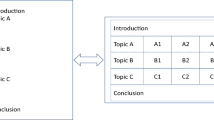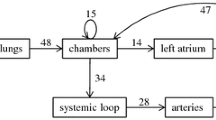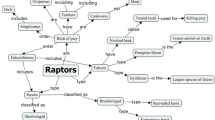Abstract
Our research aims to identify domain-specific similarities and differences of externalized cognitive structures. Cognitive structure, also known as knowledge structure or structural knowledge, is conceived as the manner in which an individual organizes the relationships of concepts in memory. By diagnosing these structures precisely, even partially, the educator comes closer to influencing them through instructional settings and materials. Our assessment and analysis of cognitive structures is realized within the HIMATT tool, which automatically generates four quantitative indicators for the structural entities of written text or causal maps. In our study, participants worked on the subject domains biology, history, and mathematics. Results clearly indicate different structural and semantic features across the three subject domains. Additionally, we found that written texts and causal maps seem to represent different structure and content across the three subject domains when compared to an expert’s representation. We conclude with a general discussion, instructional implications and suggestions for future research.


Similar content being viewed by others
References
Amthauer, R., Brocke, B., Liepmann, D., & Beauducel, A. (2001). I-S-T 2000 R. Göttingen: Hogrefe.
Anderson, J. R. (1983). The architecture of cognition. Cambridge, MA: Harvard University Press.
Anzai, Y., & Yokoyama, T. (1984). Internal models in physics problem solving. Cognition and Instruction, 1(4), 397–450.
Baalmann, W. (1997). Schülervorstellungen zur Evolution. In H. E. Bayrhuber (Ed.), Biologieunterricht und Lebenswirklichkeit (pp. 163–167). Kiel: IPN.
Baird, J. R., & White, R. T. (1982). A case study of learning styles in biology. International Journal of Science Education, 4(3), 325–337.
Bayrhuber, H. E. (2001). Biowissenschaft in Schule und Öffentlichkeit. Kiel: IPN.
Biglan, A. (1973). The characteristics of subject matter in different academic areas. Journal of Applied Psychology, 57(3), 195–203. doi:10.1037/h0034701.
Bliss, J. (1996). Piaget und Vygotsky: Ihre Bedeutung für das Lehren und Lernen der Naturwissenschaften. Zeitschrift für Didaktik der Naturwissenschaften, 2(3), 3–16.
Chase, W. G., & Simon, H. A. (1973). Perception in chess. Cognitive Psychology, 4, 55–81.
Chi, M. T. H., Feltovich, P. J., & Glaser, R. (1981). Categorization and representation of physics problems by experts and novices. Cognitive Science, 5(2), 121–152.
Chi, M. T. H., Glaser, R., & Rees, E. (1982). Expertise in problem solving. In R. J. Sternberg (Ed.), Advances in the psychology of human intelligence (pp. 1–75). Hillsdale, NJ: Lawrence Erlbaum.
Chung, G. K. W. K., & Baker, E. L. (2003). An exploratory study to examine the feasibility of measuring problem-solving processes using a click-through interface. Journal of Technology, Learning and Assessment, 2(2). Available from http://www.jtla.org.
Clariana, R. B., & Wallace, P. E. (2007). A computer-based approach for deriving and measuring individual and team knowledge structure from essay questions. Journal of Educational Computing Research, 37(3), 211–227.
Clement, J. (1981). Student’s preconceptions in introductory mechanics. American Association of Physics Teachers, 50(1), 66–71.
Courant, R., & Robbins, H. (2000). Was ist Mathematik?. Berlin: Springer.
de Corte, F., Greer, B., & Verschaffel, L. (1996). Mathematics teaching and learning. In D. C. Berliner & R. C. Calfee (Eds.), Handbook of educational psychology (pp. 491–549). New York: Macmillan.
de Vries, E. (2006). Students’ construction of external representations in design-based learning situations. Learning and Instruction, 16(3), 213–227. doi:10.1016/j.learninstruc.2006.03.006.
Donovan, M. S., & Bransford, J. D. (Eds.). (2005). How students learn. History, mathematics, and science in the classroom. Washington, D.C.: The National Academic Press.
Dummer, P., & Ifenthaler, D. (2005). Planning and assessing navigation in model-centered learning environments. Why learners often do not follow the path laid out for them. In G. Chiazzese, M. Allegra, A. Chifari, & S. Ottaviano (Eds.), Methods and technologies for learning (pp. 327–334). Sothhampton: WIT Press.
Durso, F. T., & Coggins, K. A. (1990). Graphs in social and psychological sciences: Empirical contributions to Pathfinder. In R. W. Schvaneveldt (Ed.), Pathfinder associative networks: Studies in knowledge organization (pp. 31–51). Norwood, NJ: Ablex Publishing Corportion.
Ennis, R. H. (1989). Critical thinking and subject specificity: Clarification and needed research. Educational Researcher, 18(4), 4–10.
Ennis, R. H. (1990). The extent to which critical thinking is subject-specific: Further clarification. Educational Researcher, 19(13), 13–16.
Ericsson, K. A., & Simon, H. A. (1993). Protocol analysis: Verbal reports as data. Cambridge, MA: MIT Press.
Eschenhagen, D., Kattmann, U., & Rodi, D. (2008). Fachdidaktik Biologie. Köln: Aulis Verlag Deubner.
Fleiss, J. L. (1971). Measuring nominal scale agreement among many raters. Psychological Bulletin, 76(5), 378–382.
Gentner, D., & Stevens, A. L. (1983). Mental models. Hillsdale, NJ: Lawrence Erlbaum.
Gick, M. L., & Holyoak, K. J. (1980). Analogical problem solving. Cognitive Psychology, 12, 306–355.
Glaser, R. (1999). Expert knowledge and processes of thinking. In R. McCormick & C. Paechter (Eds.), Learning and knowledge (pp. 88–102). Thousand Oaks, CA: Sage Publications.
Gruber, H. (1994). Expertise. Opladen: Westdeutscher Verlag.
Gruber, H., & Ziegler, A. (1996). Expertiseforschung. Theoretische und methodische Grundlagen. Opladen: Westdeutscher Verlag.
Hasberg, W. (2001). Empirische Forschung in der Geschichtsdidaktik. Neuried: ars una.
Herl, H. E., Baker, E. L., & Niemi, D. (1996). Construct validation of an approach to modeling cognitive structure of U.S. history knowledge. Journal of Educational Research, 89(4), 206–218.
Hilbert, T. S., & Renkl, A. (2008). Concept mapping as a follow-up strategy to learning from texts: What characterizes good and poor mappers? Instructional Science, 36, 53–73.
Holley, K. (2009). The challenge of an interdisciplinary curriculum: A cultural analysis of a doctoral-degree program in neuroscience. Higher Education, 58(2), 241–255. doi:10.1007/s10734-008-9193-6.
Ifenthaler, D. (2008). Practical solutions for the diagnosis of progressing mental models. In D. Ifenthaler, P. Pirnay-Dummer, & J. M. Spector (Eds.), Understanding models for learning and instruction. Essays in honor of Norbert M. Seel (pp. 43–61). New York: Springer.
Ifenthaler, D. (2009). Model-based feedback for improving expertise and expert performance. Technology, Instruction, Cognition and Learning, 7(2), 83–101.
Ifenthaler, D. (2010a). Bridging the gap between expert-novice differences: The model-based feedback approach. Journal of Research on Technology in Education, 43(2), 103–117.
Ifenthaler, D. (2010b). Relational, structural, and semantic analysis of graphical representations and concept maps. Educational Technology Research and Development, 58(1), 81–97. doi:10.1007/s11423-008-9087-4.
Ifenthaler, D. (2010c). Scope of graphical indices in educational diagnostics. In D. Ifenthaler, P. Pirnay-Dummer, & N. M. Seel (Eds.), Computer-based diagnostics and systematic analysis of knowledge (pp. 213–234). New York: Springer.
Ifenthaler, D., Masduki, I., & Seel, N. M. (2011). The mystery of cognitive structure and how we can detect it. Tracking the development of cognitive structures over time. Instructional Science, 39(1), 41–61. doi:10.1007/s11251-009-9097-6.
Ifenthaler, D., & Pirnay-Dummer, P. (2009). Assessment of knowledge: Do graphical notes and texts represent different things? In M. R. Simonson (Ed.), Annual proceedings of selected research and development papers presented at the national convention of the Association for Educational Communications and Technology (32nd, Louisville, KY, 2009) (Vol. 2, pp. 86–93). Bloomington, IN: AECT.
Ifenthaler, D., Pirnay-Dummer, P., & Seel, N. M. (2007). The role of cognitive learning strategies and intellectual abilities in mental model building processes. Technology, Instruction, Cognition and Learning, 5(4), 353–366.
Ifenthaler, D., & Schmidt, T. (2010). Assessing the effectiveness of prompts for self-regulated learning. In Kinshuk, D. G. Sampson, J. M. Spector, P. Isaias, D. Ifenthaler, & R. Vasiu (Eds.), Proceedings of the IADIS international conference on cognition and exploratory learning in the digital age (pp. 193–202). Timisoara: IADIS Press.
Iggers, G. G. (1996). Geschichtswissenschaft im 20. Jahrhundert. Göttingen: Vandenhoeck und Ruprecht.
Johnson, J., McKee, S., & Vella, A. (Eds.). (1994). Artificial intelligence in mathematics. New York: Oxford University Press.
Johnson-Laird, P. N. (1983). Mental models. Towards a cognitive science of language, inference, and consciousness. Cambridge, UK: Cambridge University Press.
Johnson-Laird, P. N. (1989). Mental models. In M. I. Posner (Ed.), Foundations of cognitive science (pp. 469–499). Cambridge, MA: MIT Press.
Johnson-Laird, P. N., & Byrne, R. (1991). Deduction. Hove: Lawrence Erlbaum.
Jonassen, D. H. (1987). Assessing cognitive structure: Verifying a method using pattern notes. Journal of Research and Development in Education, 20(3), 1–14.
Jonassen, D. H., Beissner, K., & Yacci, M. (1993). Structural knowledge: Techniques for representing, conveying, and acquiring structural knowledge. Hilsdale, NJ: Lawrence Erlbaum.
Jonassen, D. H., & Cho, Y. H. (2008). Externalizing mental models with mindtools. In D. Ifenthaler, P. Pirnay-Dummer, & J. M. Spector (Eds.), Understanding models for learning and instruction. Essays in honor of Norbert M. Seel (pp. 145–160). New York: Springer.
Kim, H. (2008). An investigation of the effects of model-centered instruction in individual and collaborative contexts: The case of acquiring instructional design expertise. Tallahassee, FL: Florida State University.
Kitcher, P. (1983). The nature of mathematical knowledge. Oxford: Oxford University Press.
Kleinert, E. (2005). Drei Studien zur Struktur der Mathematik. Hamburger Beiträge zur Mathematik, 229, 1–66.
Koubek, R. J., Clarkston, T. P., & Calvez, V. (1994). The training of knowledge structures for manufacturing tasks: An empirical study. Ergonomics, 37(4), 765–780.
Ku, W. A. (2007). Using concept maps to explore the conceptual knowledge of technology students: An exploratory study. Columbus, OH: Ohio State University.
Kuhn, D., Schauble, L., & Garcia-Mila, M. (1992). Cross-domain development of scientific reasoning. Cognition and Instruction, 9(4), 285–327.
Lachner, A., & Pirnay-Dummer, P. (2010). Model-based knowledge mapping. In J. M. Spector, D. Ifenthaler, P. Isaias, Kinshuk, & D. G. Sampson (Eds.), Learning and instruction in the digital age (pp. 69–86). New York: Springer.
Lee, J. (2009). Effects of model-centered instruction and levels of learner expertise on effectiveness, efficiency, and engagement with ill-structured problem solving: An exploratory study of ethical decision making in program evaluation. Tallahassee, FL: Florida State University.
Lehrer, R., & Romberg, T. (1996). Exploring children′s data modeling. Cognition and Instruction, 14(1), 69–108.
McKeown, J. O. (2009). Using annotated concept map assessments as predictors of performance and understanding of complex problems for teacher technology integration. Tallahassee, FL: Florida State University.
McPeck, J. E. (1990). Critical thinking and subject specificity: A reply to Ennis. Educational Researcher, 19(10), 10–12.
Mikkilä-Erdmann, M., Penttinen, M., Anto, E., & Olkinuora, E. (2008). Constructing mental models during learning from science text. Eye tracking methodology meets conceptual change. In D. Ifenthaler, P. Pirnay-Dummer, & J. M. Spector (Eds.), Understanding models for learning and instruction. Essays in honor of Norbert M. Seel (pp. 63–79). New York: Springer.
Mintzes, J. J., Yen, C., & Barney, E. C. (2008). Assessing knowledge, attitudes, and behavior towards charismatic megafauna. The case of dolphins. Journal of Environmental Education, 36(2), 41–55.
Mirow, J. (1991). Geschichtswissen durch Geschichtsunterricht? Historische Kenntnisse und ihr Erwerb innerhalb und außerhalb der Schule. In B. von Borries, H. Pandel, & J. Rüsen (Eds.), Geschichtsbewußtsein empirisch (pp. 53–109). Pfaffenweiler: Centaurus-Verlagsgesellschaft.
Moeira, M. A. (1983). Assessment of content and cognitive structures in physics at college level. Assessment and Evaluation in Higher Education, 8(3), 234–245.
Nason, A., & Goldstein, P. (1969). Biology; introduction to life. Menlo Park, CA: Addison-Wesley.
Nikitina, S. (2005). Pathways of interdisciplinary cognition. Cognition and Instruction, 23(3), 389–425, doi:10.1207/s1532690xci2303_3.
O’Donnell, A. M., Dansereau, D. F., & Hall, R. H. (2002). Knowledge maps as scaffolds for cognitive processing. Educational Psychology Review, 14, 71–86.
Pandel, H. (1987). Dimensionen des Geschichtsbewusstseins. Ein Versuch, seine Struktur für Empirie und Pragmatik diskutierbar zu machen. Geschichtsdidaktik, 12(2), 130–142.
Pape, M. (2006). Methodische Zugangsweisen zur Erfassung von Geschichtsbewusstsein im Kindesalter: Gruppendiskussionen und Kinderzeichnungen. In G. Hilke & M. Sauer (Eds.), Geschichtsdidaktik empirisch - Untersuchungen zum historischen Denken und Lernen (pp. 85–110). München: LIT Verlag.
Piaget, J. (1972). Das mathematische Denken. Stuttgart: Klett.
Piaget, J. (1976). Die Äquilibration der kognitiven Strukturen. Stuttgart: Klett.
Pirnay-Dummer, P., & Ifenthaler, D. (2010). Automated knowledge visualization and assessment. In D. Ifenthaler, P. Pirnay-Dummer, & N. M. Seel (Eds.), Computer-based diagnostics and systematic analysis of knowledge (pp. 77–115). New York: Springer.
Pirnay-Dummer, P., Ifenthaler, D., & Spector, J. M. (2010). Highly integrated model assessment technology and tools. Educational Technology Research and Development, 58(1), 3–18. doi:10.1007/s11423-009-9119-8.
Rips, L. J. (1994). The psychology of proof: Deductive reasoning in human thinking. Cambridge, MA: MIT Press.
Rüsen, J., Fröhlich, K., Horstkötter, H., & Schmidt, H. G. (1991). Untersuchungen zum Geschichtsbewußtsein von Abiturienten im Ruhrgebiet. In B. von Borries, H. Pandel, & J. Rüsen (Eds.), Geschichtsbewußtsein empirisch (pp. 221–344). Pfaffenweiler: Centaurus-Verlagsgesellschaft.
Ryle, G. (1949). The concept of mind. London: Hutchinson.
Schauble, L., Klopfer, L. E., & Raghavan, K. (1991). Student′s transition from an engineering model to a science model of experimentation. Journal of Research in Science Teaching, 28, 859–882.
Schnotz, W., & Bannert, M. (2003). Construction and interference in learning from multiple representation. Learning and Instruction, 13(2), 141–156. doi:10.1016/S0959-4752(02)00017-8.
Schvaneveldt, R. W. (1990). Pathfinder associative networks: Studies in knowledge organization. Norwood: NJ: Ablex Publishing Corporation.
Seel, N. M. (1999a). Educational diagnosis of mental models: Assessment problems and technology-based solutions. Journal of Structural Learning and Intelligent Systems, 14(2), 153–185.
Seel, N. M. (1999b). Educational semiotics: School learning reconsidered. Journal of Structural Learning and Intelligent Systems, 14(1), 11–28.
Seel, N. M., Ifenthaler, D., & Pirnay-Dummer, P. (2009). Mental models and problem solving: Technological solutions for measurement and assessment of the development of expertise. In P. Blumschein, W. Hung, D. H. Jonassen, & J. Strobel (Eds.), Model-based approaches to learning: Using systems models and simulations to improve understanding and problem solving in complex domains (pp. 17–40). Rotterdam: Sense Publishers.
Shavelson, R. J. (1972). Some aspects of the correspondence between content structure and cognitive structure in Physics education. Journal of Educational Psychology, 63(3), 225–234.
Shute, V. J. (2008). Focus on formative feedback. Review of Educational Research, 78(1), 153–189.
Smith, L. J. (2009). Graph and property set analysis: A methodology for comparing mental model representations. Tallahassee, FL: Florida State University.
Snow, R. E. (1989). Toward assessment of cognitive and conative structures in learning. Educational Researcher, 18(9), 8–14.
Snow, R. E. (1990). New approaches to cognitive and conative assessment in education. International Journal of Educational Research, 14(5), 455–473.
Spector, J. M. (2010). Mental representations and their analysis: An epestimological perspective. In D. Ifenthaler, P. Pirnay-Dummer, & N. M. Seel (Eds.), Computer-based diagnostics and systematic analysis of knowledge (pp. 27–40). New York: Springer.
Spector, J. M., Dennen, V. P., & Koszalka, T. A. (2006). Causal maps, mental models and assessing acquisition of expertise. Technology, Instruction, Cognition and Learning, 3(2), 167–183.
Spector, J. M., & Koszalka, T. A. (2004). The DEEP methodology for assessing learning in complex domains (final report to the national science foundation evaluative research and evaluation capacity building). Syracuse, NY: Syracuse University.
Sternberg, R. J. (1993). Giftedness as developing expertise. In K. A. Heller, F. J. Mönks, R. J. Sternberg, & R. F. Subotnik (Eds.), International handbook of giftedness and talent (pp. 55–66). Oxford: Pergamon.
Strasser, A. (2010). A functional view toward mental representations. In D. Ifenthaler, P. Pirnay-Dummer, & N. M. Seel (Eds.), Computer-based diagnostics and systematic analysis of knowledge (pp. 15–26). New York: Springer.
Taber, K. S. (1995). Development of student understanding: A case study of stability and lability in cognitive structure. Research in Science and Technological Education, 13(1), 89–99.
Tamir, P., & Jungwirth, E. (1972). Teaching objectives in biology: Priorities and expectations. Science Education, 56(1), 31–39.
Thompson, T. L., & Mintzes, J. J. (2002). Cognitive structure and the affective domain: On knowing and feeling in biology. Journal of Science Education, 24(6), 645–660.
Tversky, A. (1977). Features of similarity. Psychological Review, 84, 327–352.
von Borries, B. (2001). Lehr- und Lernforschung im Fach Geschichte. In W. Gerhard (Ed.), Lehren und Lernen im Kontext empirischer Forschung und Fachdidaktik (pp. 399–438). Donau-Wörth: Auer.
Voss, J. F., Greece, T. R., Post, T. A., & Penner, B. C. (1983). Problem-solving skill in the social sciences. In G. H. Bower (Ed.), The psychology of learning and motivation: Advances in research and theory. New York: Academic Press.
Vye, N. J., Goldman, S. R., Voss, J. F., Hmelo, C., & Williams, S. (1997). Complex mathematical problem solving by individuals and dyads. Cognition and Instruction, 15(4), 435–484.
Watts, M. (1988). From concept maps to curriculum signposts. Physics Education, 23, 74–79.
Winter, H. (1975). Allgemeine Lehrziele im Mathematikunterricht. Zentralblatt für Didaktik der Mathematik, 3, 106–116.
Wolfe, M. B. W., & Goldman, S. R. (2005). Relations between adolescents’ text processing and reasoning. Cognition and Instruction, 23(4), 467–502.
Woods, C. (2007). Researching and developing interdisciplinary teaching: Towards a conceptual framework for classroom communication. Higher Education, 54(6), 853–866. doi:10.1007/s10734-006-9027-3.
Author information
Authors and Affiliations
Corresponding author
Rights and permissions
About this article
Cite this article
Ifenthaler, D. Identifying cross-domain distinguishing features of cognitive structure. Education Tech Research Dev 59, 817–840 (2011). https://doi.org/10.1007/s11423-011-9207-4
Published:
Issue Date:
DOI: https://doi.org/10.1007/s11423-011-9207-4




